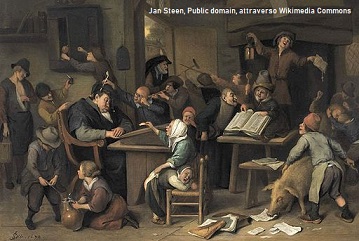Staging (E)motions: The Importance of Elvira Notari’s ‘city films’ for Twentieth-Century Immigrant and Female Audiences
DOI:
https://doi.org/10.54103/2035-7680/17900Parole chiave:
Elvira Notari; city films; (e)motions; cultural immigration; gender representationAbstract
This article explores the significant social changes registered by woman film director Elvira Notari in her city films, particularly regarding the position of women and Italian immigrant audiences in the US. It thus suggests new readings of Notari’s work through the concepts of urban capabilities and the flâneuse. As most of her original dense archive has been almost lost, only the extant feature film È Piccerella as well as secondary material and scholarship retrieving her work will be used to analyze the contributions of the director to cultural immigration, gender representation and film history.
Metriche
Riferimenti bibliografici
Bayman, Louis. The Operatic and the Everyday in Postwar Italian Film Melodrama. Edinburgh UP, 2014.
Bruno, Giuliana. Atlas of Emotion: Journeys in Art, Architecture, and Film. Verso, 2007.
---. “City Views: The Voyage of Film Images.” The Cinematic City, edited by David Clarke. Routledge, 1997. pp. 47–61.
---. Rovine con vista: Alla ricerca del “cinema perduto” di Elvira Notari. La Tartaruga, 1995.
---. Streetwalking on a Ruined Map: Cultural Theory and the City Films of Elvira Notari. Princetown UP, 1993.
Bruno, Giuliana, and Maria Nadotti. Off Screen: Women and Film in Italy. Routledge, 2014.
Cannistraro, Philip V., and Gerald Meyer, editors. The Lost World of Italian American
Radicalism: Politics, Labor and Culture. Praeger, 2003.
Carrera-Suárez, Isabel. “The Stranger Flâneuse and the Aesthetics of Pedestrianism: Writing the Post-Diasporic Metropolis.” Interventions vol. 17, no. 6, 2015, pp. 853-865.
Collie, Natalie. “Walking in the City: Urban Space, Stories, and Gender.” Gender Forum 42, 2013, pp. 3-15.
Connel, William J. “A New History for a New Millenium.” The Routledge History of Italian Americans, edited by William J. Connell and Stanislao G. Pugliese. Routledge. 2018. pp. 1-15.
Cruzado-Rodriguez, Ángeles. “Elvira Notari: Unos ojos Napolitanos detrás de la cámara.” Italia-España-Europa: Literaturas comparadas, tradiciones y traducciones, edited by Mercedes Arriaga Florez, et al.. Arcibel, 2006. pp 40-47.
Domosh, Mona, and Joni Seagar. Putting Women into Place: Feminist Geographers Make Sense of the World. The Guilford Press, 2001.
È Piccerella. Directed by Elvira Notari, Film Dora 1921, https://www.youtube.com/watch?v=XT6dpElN-eA. Accessed 22 Feb. 2019.
Ferrara, Orazio. Addio Sud: O briganti o emigranti. Capone, 2012.
Frasca, Simona. Italian Birds of Passage: The Diaspora of Neapolitan Musicians in New York. Palgrave, 2014.
Gabaccia, Donna. Italy’s Many Diasporas. Taylor & Francis, 2000.
---. “Women of the Mass Migration: From Minority to Majority, 1820–1930.” European Migrants. Global and Local Perspectives, edited by Dirk Hoerder and Leslie P. Moch. Northeastern UP, 1996. pp. 90-111.
Gabaccia, Donna, and Colin Wayne Leach, editors. Immigrant Life in the U.S.: Multi-disciplinary Perspectives. Routledge, 2004.
Gardini, Walter. Syria Poletti: mujer de dos mundos. Asociación Dante Alighieri, 1994.
Immigrant Son: The Story of John D. Mezzogiorno. Directed by Frank Cappiello. Lux Vista Films, DVD, 2012.
Lutters, Wayne G., and Mark S. Ackerman. “An Introduction to the Chicago School of Sociology.” Interval Research Proprietary, 1996.
Miscuglio, Annabella. “An Affectionate and Irreverent Account of Eighty Years of Women’s Cinema in Italy.” Off Screen: Women and Film in Italy: Seminar on Italian and American Directions, edited by Giuliana Bruno and Maria Nadotti. Routledge, 1988. pp. 151-165.
Nazzaro, Pellegrino. “The Mezzogiorno and The Questione Meridionale in Italian Historiography.” Italian Americans: Bridges to Italy, Bonds to America, edited by Luciano J. Iorizzo and Ernest E. Rossi. Teneo, 2010. pp. 233-267.
Guglielmo, Jennifer. Living the Revolution: Italian Women’s Resistance and Radicalism in New York City, 1880–1945. University of North Carolina Press, 2010.
Guglielmo, Thomas. White on Arrival: Italians, Race, Color, and Power in Chicago, 1890-1945. Routledge, 2003.
Handlin, Oscar. The Uprooted. Little Brown, 1979.
Laurino, Maria. The Italian Americans: A History. Norton, 2015.
Mangione, Jerre, and Ben Morreale. La Storia: Five Centuries of the Italian American Experience. Harper Perennial, 1992.
Muscio, Giuliana. “Introduction.” Napoli/New York/Hollywood: Film between Italy and the United States. Fordham University Press, 2018. pp. 1-20.
Park, Robert E. “Human Migration and the Marginal Man.” American Journal of Sociology vol. 33, no. 6, 1928, pp. 881-893.
Paternostro, Rocco. “Motivi storici, politici, economici e social dell’emigrazione italiana.” Letteratura italiana dell’emigrazione, con antologia dei testi, edited by Rocco Paternostro. Aracne, 2011. pp. 13–59.
Perlmann, Joel. “Views of European Races among the Research Staff of the US Immigration Commission and the Census Bureau, ca. 1910.” Levy Economics Institute Working Paper Collection 648, 2011, 1–32.
Petit, Jeanne D. The Men and Women We Want: Gender, Race, and the Progressive Era Literacy Test Debate. University of Rochester Press, 2010.
Sassen, Saskia. Guests and Aliens. The New Press, 1999.
--. “Urban Capabilities: An Essay on Our Challenges and Differences.” Journal of International Affairs, vol. 65, no. 2, 2012, 85–95.
Scalia, Rossella. “Elvira Notari: A Woman in Search of Desire.” Film International, 2013, http://filmint.nu/?p=9490. Accessed 19 Oct. 2019.
Shiel, Mark. “Neorealism and the City.” Italian Neorealism: Rebuilding the Cinematic City, edited by Mark Shiel. Columbia University Press, 2006. pp. 63–80.
Tamburri, Anthony J. To Hyphenate or Not To Hyphenate? The Italian/American Writer: An Other American. Guernica, 1991.
Tomadjoglou, Kim. “Elvira Notari.” Women Film Pioneers Project, edited by Jane Gaines, et al. Center for Digital Research and Scholarship. Columbia University Libraries, 2013, https://wfpp.cdrs.columbia.edu/pioneer/ccp-elvira-notari. Accessed 19 Oct. 2019.
Verga, Giovanni, translated by Cecchetti, Giovanni. The She-Wolf and Other Stories. University of California Press, 1973.
Dowloads
Pubblicato
Come citare
Fascicolo
Sezione
Licenza

Questo articolo è soggetto a licenza Creative Commons Attribution-NonCommercial-NoDerivatives 3.0 International License.




